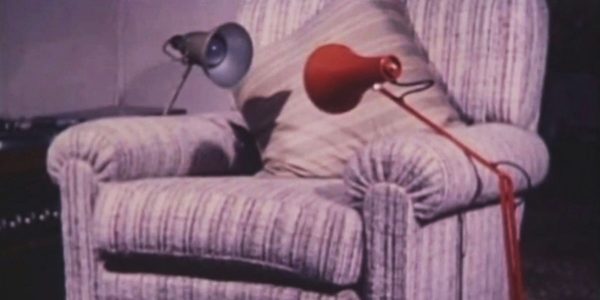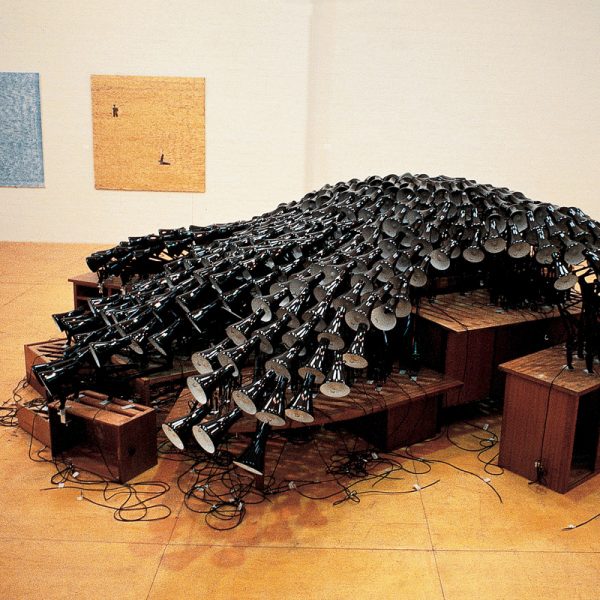The Original 1227 Desk Lamp
Eibhlín Doran
When George Carwardine designed the Original 1227 desk lamp in 1935 he had no idea that this “minor miracle of balance” would become a design classic and true British icon. The task lamp, primarily manufactured for the home but also popular in working environments, is still extremely popular and remains in production by Anglepoise today.1 By using Madeline Akrich and Bruno Latour’s Actor-Network Theory (ANT) as a theoretical framework, this essay examines why clarity in an object’s intended script cannot prevent the misuse of the object. The Original 1227 lamp is a technical object with a clear objective, therefore a methodological approach such as ANT can be seen as an appropriate framework with which to analyze the intricate relations between actors and networks.

The lamp’s heavy cast iron base with steel cover measures 15×15 cm and stabilizes the lamp. Connected to the base is a 360° rotating mechanism which contains the Anglepoise logo and model number. (Fig. 1) From the base, the lightweight aluminum arm is connected via three springs. This “constant tension spring technology”—pioneered by Anglepoise—is vital to the lamp’s broad range of movement. (Fig. 2) Flexibility is delegated to the springs, allowing the lamp to stretch to 60 cm (from base to shade) while providing perfect balance. The aluminum shade, connected to the arm, has a diameter of 14.5 cm and the height of 15 cm. The lampshade, in which the 220–240V lightbulb is neatly concealed, can be rotated in order to illuminate a particular component at any angle. All visible fittings, including the springs and branded mechanism, are chrome plated while the base and body are gloss painted. Additional nonhuman actors include the on/off switch and the plug, both connected to the 200 cm-long cable that runs up through the arm and into the lampshade. When connected to a source of electricity this cable provides power to the light bulb.2
By implementing the Actor-Network Theory method and using Latour’s terminology from the article “Where Are the Missing Masses? The Sociology of a Few Mundane Artifacts,” we see that a clear script depletes the risk of anti-programs and re-inscription but cannot prevent the user de-inscribing from the prescribed script.3
In 1931, automotive engineer George Carwardine developed the concept for the “constant tension spring technology.” With this patented system, the springs (as a substitute for weights) are delegated the nonhuman character of holding the lampshade in a desired position. The first four-spring Anglepoise lamp incorporated this spring technology. However, the model was deemed too industrial and a three-spring version was developed. Production of the Original 1227 began in 1935 and continues today, hence why this model is perceived as the archetypal Anglepoise.4 The lamp, supported and balanced by the springs, remains in position after being rotated in every conceivable direction.5 This pioneering “constant tension spring technology” is vital to the desk lamp’s broad range of movement and ongoing commercial success.6 Despite the initial alterations to avoid discrimination against the domestic market, the script of the task lamp has not changed and the product has been in production ever since.7
Carwardine’s inscription of the various human and nonhuman actors, as well as networks remains unambiguous to the user, despite it being over eighty years since the lamp was first designed. The transparency of the script clearly indicates that the object’s fundamental purpose is to perform as a task lamp. This is most apparent in the object’s flexible yet firmly balanced form. For example, Carwardine’s inscription for the heavy, flat base is to provide a balance for the lamp and prescribes that the human actor places the object on a stable surface such as a desk or counter. The weight also suggests that it has not been designed as a portable object and should therefore be placed in a suitable space such as a study or office. The task of being flexible is inscribed in the visible springs and fittings. Carwardine prescribes that the imagined user will adjust the articulated arm and lampshade to the desired position. The form invites the user to engage with the lamp while the ease with which the arm and lampshade co-ordinate reassures the user that this is indeed the prescribed function. Therefore, by subscribing to the prescribed function the human actor can concentrate the beam of light to illuminate a particular area while the nonhuman actors hold the beam in place. Despite being partially concealed within the lampshade, the lightbulb is still visible, leaving no further doubt about what the purpose of this utilitarian mechanism. Other nonhuman actors such as the plug, cord, and on/off switch carry the inscription that, in order to have power, the lamp must be connected to a nearby source of electricity. Again, by the user subscribing to the prescribed network of the lamp being plugged in, the on/off switch permits them to turn the lamp on or off when needed.
In most cases, a clear script ensures that the actors can easily subscribe to it, avoiding possible anti-programs and any further re-inscriptions. But what happens when the user deliberately de-inscribes and underwrites the inscribed or prescribed function of the object? As design theorist Kjetil Fallan explains in his book Design History: Understanding Theory and Method, there is always a chance that the actors make an informed decision not to play the role the designers ascribe to them or that the users misunderstand, ignore, discard or reject the instruction manual and define their roles and the product’s use and meaning at odds with the producer’s or designer’s intentions, as conveyed through the script.8

Although the transparency of the script does not allow for any alternative interpretation of what the object should be used for, the physical script does contain qualities that are not deliberately inscribed into the lamp. For example, the lamp’s ability to be flexible and stable gives it a friendly and approachable human quality. The witty resemblance to the human form has been played upon in Peter Ryde’s 1977 short film “Wranglepoise.” (Fig. 3) The film features the Original 1227 as the protagonist, along with the now-retired 1970s lamp, the Model 75, together with a cameo from another 1970s Anglepoise design, the Model 82, bringing the human characteristics of the famous Anglepoise design into the limelight.
The flexibility of the articulated lamp reflects human gestures in an endearing manner. The physical form of the lamp comes to life, taking the role of the human actor while using nonhuman actors such as the plug, lightbulb, and lead as obstacles. The narrative is derived from the lamp (as the human actor) subscribing to the prescribed function of being plugged in. A quarrel begins when the Original 1227 lamp’s plug is removed from the socket by the Model 75, depriving the lamp of its ability to generate light. This is followed by a battle and the breaking of the bulb before the two lamps eventually make peace.9 In this short film, the function of the object remains the same (to project light) but the physical script has taken on an entirely new entity.

Figure 4. “The Giant Hand Sculpture named Knuckle Shuffle,” David Mach, 1985. Photo courtesy of Anglepoise.
Another example that incorporates the Anglepoise lamp’s anthropomorphic qualities can be seen in the work of sculptor David Mach. Mach created “The Giant Hand Sculpture named Knuckle Shuffle” in 1985 from 360 black Anglepoise lamps. (Fig. 4)10 In this sculpture, the form of the Anglepoise has been taken advantage of, creating the shape of a giant hand, while the practical function of the lamp has simply been ignored, reiterated by the fact that the plugs have been removed.
The clever use of multiple lamps employed outside of their intended purpose, in the context of a gallery, has a surprising impact on the viewer. The physical script takes on a new, unintentional meaning. Although the playful use of the Original 1227 in the two examples is not representative of the common use by consumers, it illustrates that even when a script is clear, the designer can never entirely predict the reaction of the anticipated actors.
In conclusion, we can see that a clear object script depletes the risk of anti-programs but can never entirely prevent them. By studying the Anglepoise Original 1227 we can see that ignoring the script can sometimes lead to interesting alternative treatments—although often not the most functional or practical. Fallan states that the construction of meanings of design and design ideology is not necessarily a smooth operation. No matter how well-intended the designers’ inscriptions and programs are, more or less convincing anti-programs are likely to be formed.11 Therefore, despite the fact that the Original 1227 has a single objective—to provide a source of light which can be focused on an area—it is impossible to pre-determine how the individual user will engage with it, as illustrated by the examples above. By using Actor-Network Theory, it has been possible to investigate the technological aspects of the object and utilize internal evidence to study the necessary roles between active agents in a network.
1 “Our story,” Anglepoise, https://www.anglepoise.com/about.↵
2 “Product,” Anglepoise, https://www.anglepoise.com/product/original-1227-desk-lamp.↵
3 Bruno Latour, “Where Are the Missing Masses? The Sociology of a Few Mundane Artifacts,” in The Object Reader, ed. Fiona Candlin and Raiford Guins, (London/New York: Routledge, 2009), 232.↵
4 “Our story,” Anglepoise.↵
5 “Anglepoise,” Design Museum, http://designmuseum.org/design/anglepoise.↵
6 “About,” Anglepoise, https://www.anglepoise.com/product/original-1227-desk-lamp.↵
7 “Anglepoise,” Design Museum.↵
8 Kjetil Fallan, Design History: Understanding Theory and Method (London: Bloomsbury Publishing, 2010), 82.↵
9 “Lights. Camera. Action,” Anglepoise, https://www.anglepoise.com/blog/2014/11/lights-camera-action.↵
10 “Our story,” Anglepoise.↵
11 Kjetil Fallan, Design History: Understanding Theory and Method, 82.↵
Author Affiliations
Eibhlín Doran
MA Design Cultures, VU University, Amsterdam.

 DESIGN STUDIES BLOG
DESIGN STUDIES BLOG

